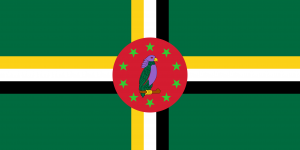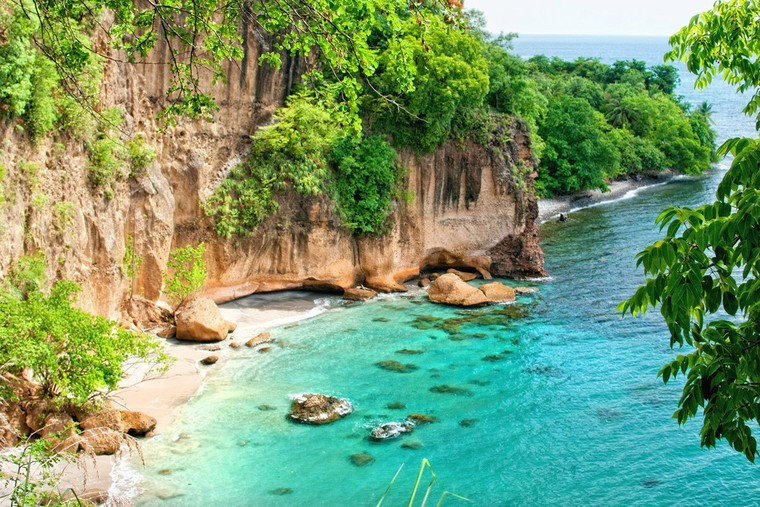Language/English/Culture/Dominica-Timeline
Jump to navigation
Jump to search
Rate this lesson:
Historical Timeline for Dominica - A chronology of key events
History of Dominica[edit | edit source]
Pre-Columbian era[edit | edit source]
- The indigenous people of the island of Dominica were the Arawaks, who were driven out or exterminated by the Caribbean Indians during the fourteenth century. The first European to land on the island of Dominica was Christopher Columbus in November 1493.
- Throughout the sixteenth century, Spain made regular attempts to annex the island, but resistance from the Caribbean prevented it.
- In 1635, France in turn claimed Dominica. French missionaries settled there and became the first European inhabitants of the island. Nevertheless, conflicts with the Caribbean continued, so much so that, in 1660, the French and the English decided that the colonization of Dominica and Saint-Vincent should be abandoned.
- Dominica was officially declared "neutral" for the next century, but its natural resources remained attractive, and by the beginning of the 18th century British and French logging expeditions came to harvest timber on the island.
Colonial history[edit | edit source]
- The French seized the island of Dominica in 1778 during the American War of Independence and then returned it in 1783 when peace returned.
- Due to Dominica's geographical position between Martinique and Guadeloupe, France gradually became the predominant power on the island, which then became a French colony. But, at the end of the Treaty of Paris of 1763 which put an end to seven years of Franco-English war, the island became a British possession.
- In 1778, during the American Revolution, the French invaded the island with the active cooperation of the population, which was largely French. The Treaty of Paris of 1783, which ended the war, returned the island to Great Britain. Other French invasion attempts took place in 1795 and 1805, but were unsuccessful.
- In 1763, the English established a legislative assembly there, representing only the white population. In 1831, reflecting a relaxation of British colonial policy, a new law granted civil rights to free non-whites. Three blacks were elected to the legislature the following year.
- After the abolition of slavery in Dominica in 1838, the island became the first (and only) British colony to have local government led by blacks in the 19th century. Most of the black representatives were small landowners or traders who had economic and social views diametrically opposed to the interests of the large white planters.
- Faced with the threat, the planters demanded from the crown that the island be placed under the colonial rule of direct rule, that is, direct administration by the United Kingdom. Thus, in 1865, after much agitation and tension, the British colonial administration replaced the assembly with an assembly made up of 50% of elected members and 50% of members appointed by the United Kingdom, more favorable to the interests. planters.
- In 1871 Dominica became part of the Leeward Islands Federation and the influence of the black population gradually waned.
- In 1896, the island again became a crown colony, administered by the colonial administration with less autonomy. The political rights of the majority of the population were thus diminished. However, the British government offered development aid as compensation.
- After the First World War, the influence of public opinion in the Caribbean, in favor of more autonomy, led to the formation of a parliamentary political party, the representative government association. Thanks to the absence of strong opposition and playing on the frustration of the Dominican population, this party won a third of the seats elected in the legislative assembly in the elections of 1924 and half in that of 1936.
- Subsequently, Dominica was transferred from the colonial administration of the Leeward Islands to that of the Windward Islands, until 1958, when the island joined the ephemeral Federation of the West Indies.
- In 1961, a Labor government led by Edward Oliver LeBlanc was elected in Dominica.
- After the dissolution of the West Indian Federation, Dominica became an associated state with the United Kingdom (February 27, 1967) and the local government then took responsibility for its internal affairs. Edward Oliver LeBlanc left power in 1974 and was replaced by Patrick John.
- On November 3, 1978, the United Kingdom granted independence to Dominica.
Since independence[edit | edit source]
- Despite independence, the island's economic situation did not improve, and in mid-1979 political discontent led to the formation of a new government headed by Oliver Seraphin. It was replaced in 1980 by the government of Eugenia Charles, following the victory of the Dominica Freedom Party in the elections. Eugenia Charles will be the first woman appointed to the post of Prime Minister in the West Indies.
- On April 27, 1981, members of the Ku Klux Klan were arrested in New Orleans as they planned a coup to restore power to Patrick John, former prime minister from 1974 to 1979 and the architect of the independence, and install a segregationist regime ("Operation Red Dog") as well as lucrative businesses (casinos, prostitution and drugs).
- The island's economic problems continued, made worse by the hurricanes of 1979 and 1980. By the late 1980s, the economy had more or less recovered, but the decline in banana prices in the 1990s will weaken it again.
- In 1996, Eugenia Charles left the prime minister's office, she was replaced by Edison James until 2000 who lost the elections and Rosie Douglas (labor power) took her place and who died in office after a few weeks, then by Pierre Charles until in 2004 (who also died in office). Since 2004, the Prime Minister has been Roosevelt Skerrit.
Sources[edit | edit source]
- https://fr.wikipedia.org/
- (en) Lennox Honychurch, The Dominica story: a history of the island, London, Dominique, MacMillan education, 1995 (ISBN 9780333627761)
World Timelines[edit source]
Other Lessons[edit | edit source]
- British Virgin Islands Timeline
- Australia Timeline
- Heard McDonald Islands
- Christmas Island Timeline
- Puerto Rico Timeline
- Guernsey Timeline
- Bahamas Timeline
- Baseball
- Timeline of the United States
- Best personal development books
- Gibraltar Timeline
- South Georgia South Sandwich Islands Timeline
- Countries where English is the Official Language
- St Helena Timeline


